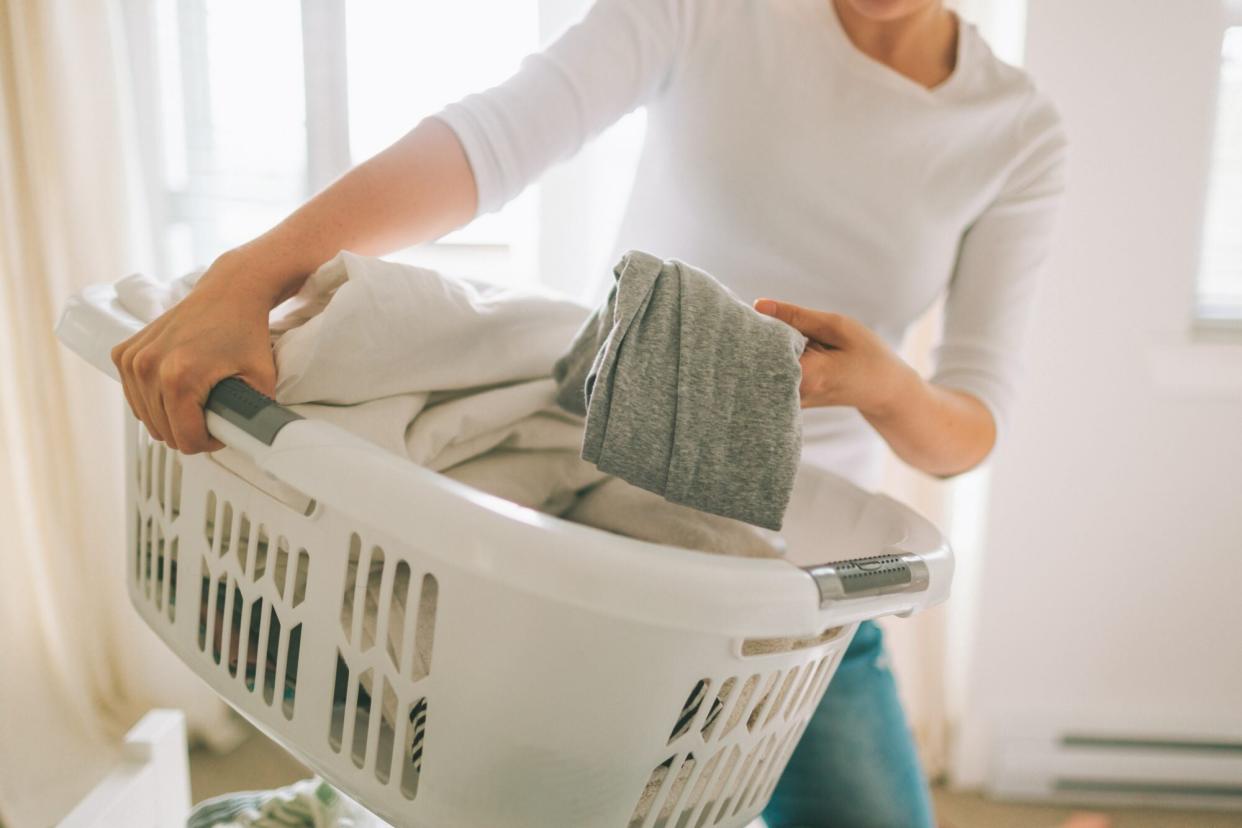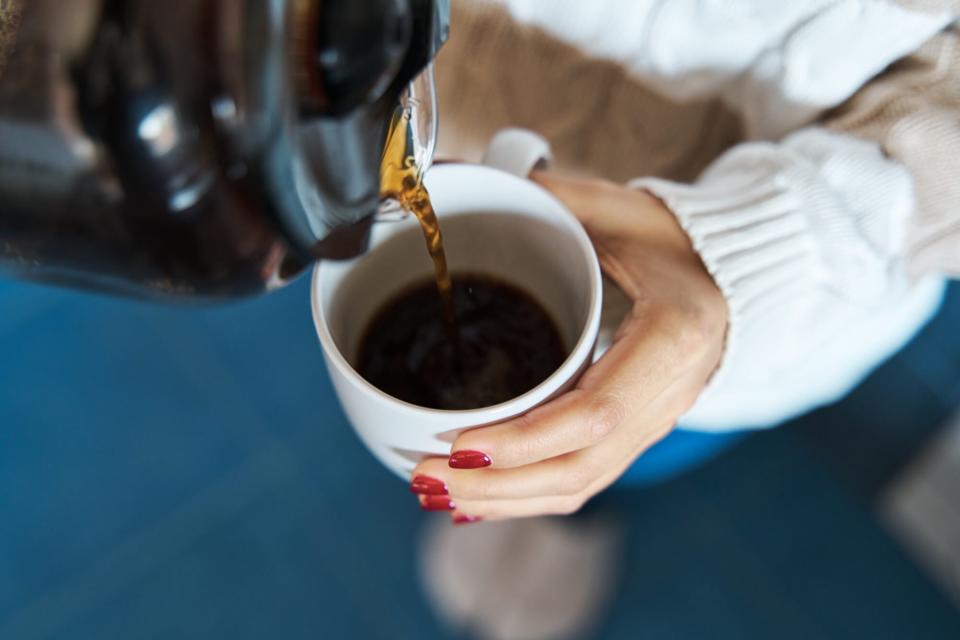How to Remove Every Type of Stain, From Grease and Coffee to Wine and Lipstick

Crystal Sing / GETTY IMAGES
TABLE OF CONTENTS
On This Page
Grease
Protein (Like Blood or Yolk)
Fruit or Vegetables
Grass
Mud
Wine
Coffee or Tea
Chocolate
Wax or Gum
Lipstick
Sauces
Ink
Whether it's from cooking dinner or doing work in your garden, getting a few stains on your clothes is a common occurrence. But not all stains were created equally—they each have specific properties that require their own unique cleaning solutions. What might get out a grease mark, for example, might not be conducive to eliminating a coffee stain. No matter what type of spot you're dealing with though, there is a cleaning solution out there that can return your piece to its original condition. The first step? Identifying the type of stain you need to treat.
Related: How to Remove Those Stubborn, Baked-On Stains From Your Favorite Stoneware Cooking Pieces
Make a DIY Cleaning Solution
Don't panic if you've noticed a stain on your favorite blouse or trousers—most stains can be treated using common household cleaning supplies. Many of the spots outlined below, for example, are removed with our DIY diluted dishwashing soap solution. Make sure to use a soap that's fragrance- and dye-free and contains sodium lauryl sulfate or sodium laureth sulfate. Note that if you're cleaning protein fibers, like silk, wool, cashmere, or angora, you should't use the enzyme detergent instructed below.
Combine 1 tablespoon of liquid soap and 9.5 ounces of water.
Pour it into a tiny spray bottle.
Shake to combine.
Grease
Whether you're cooking chicken or making your favorite salad dressing, you know how difficult grease stains can be to remove.
Start by covering the affected area with a dry solvent—like mineral spirits or acetone—in a ventilated room.
Use an eyedropper to rinse the spot with isopropyl alcohol and dry well.
Spray diluted dishwashing soap solution on any remaining residue, and soak the item in an enzyme detergent.
Wash according to label instructions.
Protein (Like Blood or Yolk)
If you've ever gotten a little blood on your blouse or some stray yolk when cracking an egg, you've dealt with a protein stain.
Spray diluted dishwashing soap solution on stain and let it sit.
Rinse in tepid water.
If stain remains, treat area with an enzyme detergent.
Wash according to label instructions.
Fruit or Vegetables
The natural dyes on fruits and vegetables can leave behind stains when they come in contact with fabric.
Spray diluted dishwashing soap solution on the stain to remove sugars.
Using an eyedropper, flush the area with white vinegar and then hydrogen peroxide to remove any remaining color.
Follow up with an enzyme detergent to remove residue.
Wash according to label instructions.

Carolin Voelker / GETTY IMAGES
Grass
Whether your children were playing outside or you were doing yard work, grass stains are easy to come by—especially during warmer weather.
Treat area with a dry solvent in a well-ventilated room.
Press with cheesecloth and tamp with a soft-bristled brush.
Repeat to remove as much pigment as possible.
Flush area with isopropyl alcohol, tamp, and let dry.
Follow up with an enzyme detergent to remove residue.
Wash according to label instructions.
Mud
Mud stains are another causality of spending time outdoors. If the stain is mixed with grass, follow the instructions above. However, pure mud stains are easier to treat, as you don't have to worry about the grass pigment bleeding into your clothes.
Shake or scrape off residue.
Pre-treat stain with diluted dishwashing soap solution, and soak.
Treat with an enzyme detergent.
Wash according to label instructions.
Wine
Spilled some wine on your carpet or clothes while sipping on your evening glass? Don't fret. Removing both red and white wine stains has never been easier.
Red Wine
Spray diluted dish washing soap solution on stain and tamp with a soft-bristled brush.
Flush with water, apply white vinegar, and tamp.
Let stand several minutes and flush again.
If stain remains, apply hydrogen peroxide, and let stand.
If stain still persists, apply one or two drops of ammonia to wet area. Flush with water.
Treat with an enzyme detergent and wash according to label instructions.
If stain is still there, apply a powdered non-chlorinated, color-safe bleach, such as sodium percarbonate on the stain
Rewash according to label instructions.
White Wine
Flush the stain with cold water.
Spray with diluted dishwashing soap solution.
Treat area with an enzyme detergent.
Wash according to label instructions.

juanma hache / Getty Images
Coffee or Tea
From your morning cup of coffee to your nightly mug of tea, stains from these beverages are common but a cinch to treat.
Using an eyedropper, flush area with lemon juice or white vinegar to remove stain.
Treat with a stronger bleach, if necessary.
To help remove sugar or milk, spray area with diluted dishwashing soap solution.
Treat area with an enzyme detergent.
Wash according to label instructions.
Chocolate
Bits of broken off chocolate can quickly melt into your clothes if left unnoticed. We recommend scraping off the excess before machine washing, so the detergent can really penetrate the stain.
Gently scrape off excess chocolate.
Spray area with diluted dishwashing soap solution.
Treat area with an enzyme detergent to remove residue.
Wash according to care instructions.
Wax or Gum
These sticky substances are easier to treat when they're frozen, which can be done by applying ice to the spot or by placing the item in the freezer.
Once frozen, scrape or crack off as much of the substance as you can.
Remove residue with an oil solvent or mineral spirits.
Rinse with isopropyl alcohol and let dry.
Treat with an enzyme detergent
Wash according to care instructions.

GETTY IMAGES
Lipstick
It happens—you fix your lipstick with your finger then transfer it to your shirt. Although it's a frustrating beauty mishap, the stain is far from permanent.
Use a dull-edged knife to remove excess lipstick.
Using an eyedropper, apply a dry solvent in a well-ventilated room and tamp with a soft-bristled brush.
Flush area with isopropyl alcohol, and tamp.
Repeat until all stain is removed and let dry.
Spray with diluted dishwashing soap solution.
Treat area with an enzyme detergent.
Wash according to care instructions.
Sauces
From mustard and ketchup spilling out of your burger bun to drips of soy sauce when dipping a piece of sushi, condiments are probably one of the most common stains you get on your clothes.
Mustard
Using an eyedropper, flush stain with vinegar.
Wash according to care instructions with diluted dishwashing soap solution.
Ketchup and Barbecue Sauce
Scrape off sauce
Spray area with diluted dishwashing soap solution.
Soak in tepid water.
If color remains, apply white vinegar with an eyedropper.
Treat with an enzyme detergent and wash according to label instructions.
If color still persists, apply several drops of hydrogen peroxide and let sit.
Rinse and treat again with enzyme detergent.
Wash according to care instructions.
Soy Sauce
Spray with diluted dishwashing soap solution and tamp with a soft-bristled brush.
Flush with water, apply white vinegar, and tamp
Let stand for several minutes and flush again.
If stain remains, apply hydrogen peroxide, and let stand.
If stain still persists, apply one or two drops of ammonia to wet area and flush with water.
Treat with an enzyme detergent and wash.
If stain is still there, apply a powdered non-chlorinated color-safe bleach, such as sodium percarbonate and rewash according to care instructions.
Vinaigrette
First, treat stain as a grease stain following the instructions outlined above.
Flush with white vinegar to remove any remaining stain.
Follow up with an enzyme detergent to remove residue.
Wash according to care instructions.

LaylaBird / GETTY IMAGES
Ink
Writing mishaps are a thing, too. If you swiped your clothes with a pen, the first step—no matter the type of ink you're dealing with—is to build a dam around the stain with mineral oil or petroleum jelly. Always work within the confines of the dam to prevent the stain from spreading.
Ballpoint Ink
Treat area with isopropyl alcohol using an eyedropper.
Remove any remaining pigment with a dry solvent in a well-ventilated room and let dry.
Rinse with diluted dishwashing soap solution.
Treat with an enzyme detergent.
Wash with warm water.
Felt Tip Ink
Test the ink with a cotton swab saturated with water and one saturated with isopropyl alcohol to determine whether oil-based or water-based ink. Whichever solvent pulls more pigment out of the stain is the one you should use.
If isopropyl alcohol is more effective, follow the steps for ballpoint ink stains listed above.
If water is more effective, spray the stain with diluted dishwashing soap solution.
Flush stain with cold water.

